Piaroa
High in the Andes,
Higher in the Amazon
© 2011 Tor Pinney - All
Rights Reserved
“Primitive
rainforest dwellers! The very words tantalized my
imagination, but nothing prepared me for the quirky,
enlightening adventure awaiting us deep in the Venezuelan
Amazon.”
~
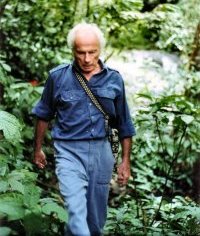 |
My
father joined me aboard my
sailboat, Sparrow, in Puerto La Cruz, Venezuela. This
time he didn’t come
for the sailing, though. Our
goal was to
explore some of Venezuela’s diverse interior together, mostly by car
and small plane, but as it turned out also by foot, horseback and dugout
canoe.
<-- click
photos to enlarge --> |
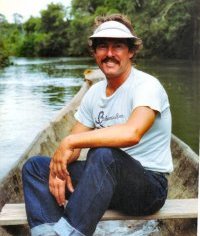 |
I left Sparrow in
the care of another skipper and Dad & I flew to Caracas,
where we rented a car and immediately headed west. I was
anxious to get to the Andes, my first visit
to South America's legendary mountain range. My father was up for
that, too, but his real passion had always been tropical
rainforests and the animals and primitive tribes that
inhabit them. So we had agreed to do both, traverse the
Andes and then visit Venezuela's Amazon region. It is
this second half of our trip, the Amazon, that I want to
tell you about, but here's a photographic peek at the Andes.
Throughout this web page, you can click on the smaller photos to
enlarge them.
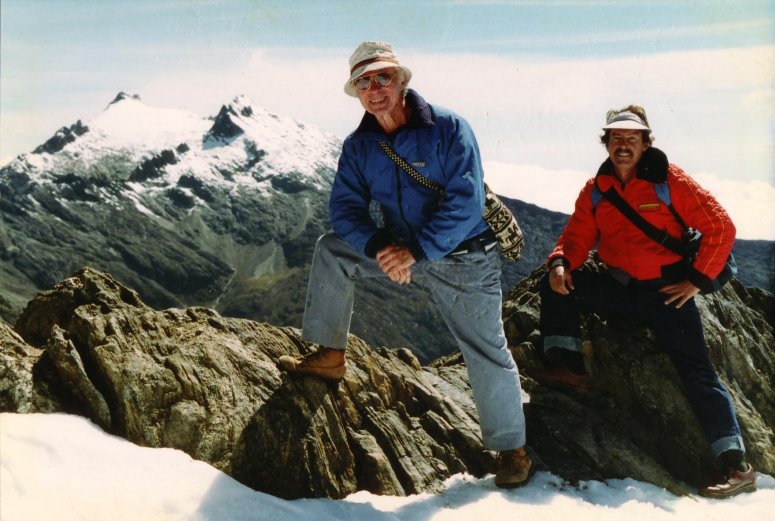
click thumbnails to
enlarge:
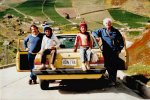
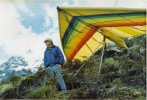
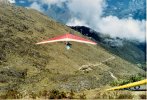
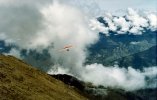


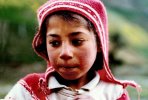
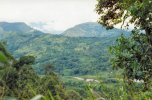
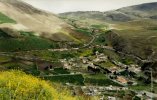


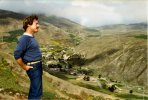
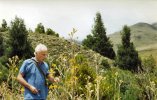
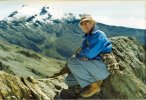
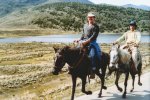
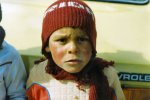


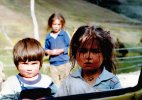

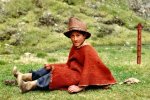
The week and a half we
spent traveling through the Andes was full and fun. Too soon, it seemed, we were dropping off
the rental car in the mile-high city of Merida and boarding a shuttle flight towards
the next phase of our adventure, another world
altogether. We had to layover in
Caracas en route, but the next afternoon a twin-engine plane deposited us
on the unpaved landing strip in Puerto
Ayacucho, a rough-hewn frontier town on the upper Orinoco
River deep in the Amazon region of southernmost Venezuela.
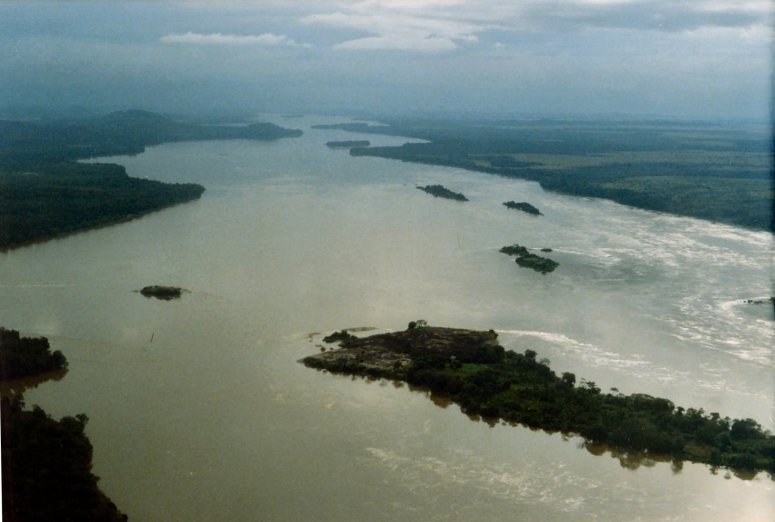
We spent the night there,
then moved to a no-frills eco-tour camp miles from town, wedged into the
unabated Amazon jungle. (My father was quick to correct my
vocabulary,
explaining that the word “jungle” is passé; it's called
“rainforest” these days. No doubt, but when I first beheld that impenetrable mass of
foliage gone ballistic it sure looked like jungle to me, the
kind that makes you want to pound your chest and yodel like
Tarzan.)
At the camp we were
assigned
a small bunkhouse entirely to ourselves. It was the slow
season; Dad and I were the only guests, with our
choice of wood plank cots from a double row of them, each
covered with a thin mattress and a mosquito tent. We spent the next few
days exploring the Orinoco River and its tributaries,
traveling with local guides in cayucos, dugout canoes carved
from solid tree trunks, ours powered by outboard motors, the
local Indios' by hand-carved paddles. At the end of each day we'd
return to our base camp sweaty, tired and happy.
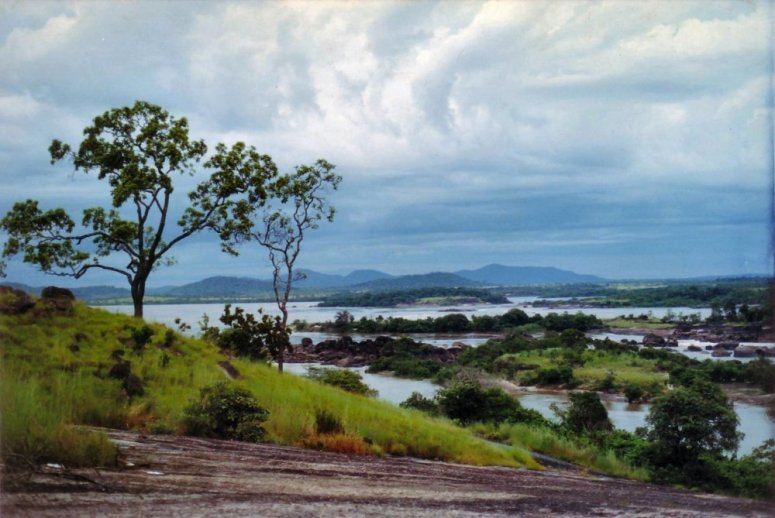
click thumbnails to
enlarge:

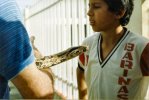

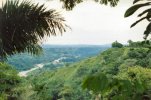
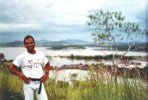
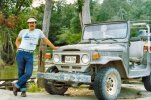
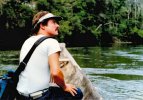
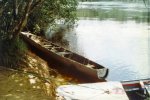
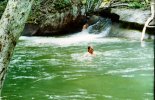

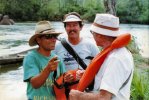
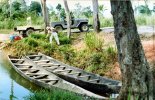
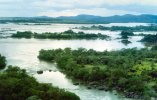
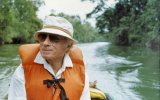
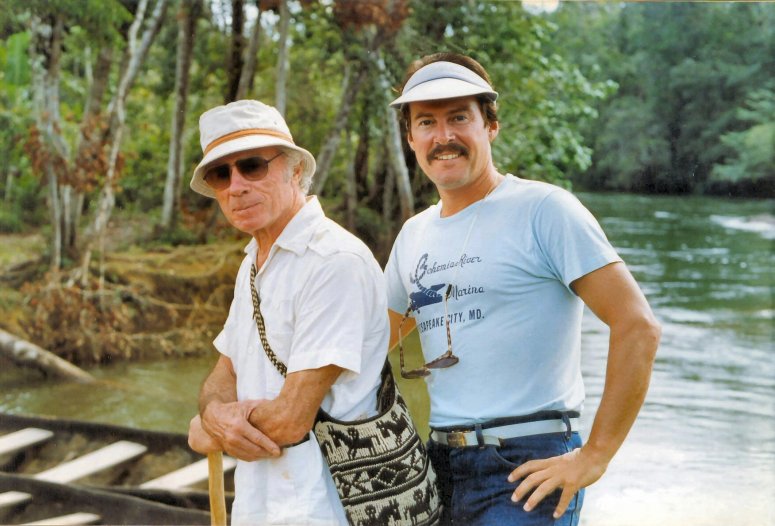
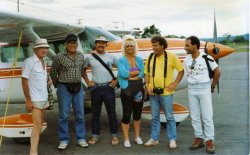 |
One day
we shared a small charter plane with a European couple, to
see some of this amazing terrain from the air.
|
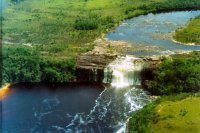 |
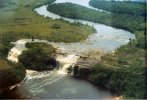
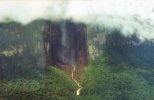
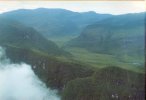
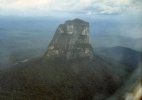
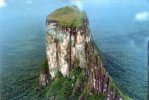
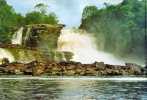
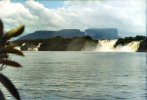
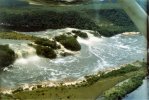
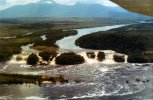
click
thumbnails to enlarge
|
That evening after supper
several of the young Venezuelan guides were having a beer
together on the porch, passing a guitar around and
entertaining themselves with popular Venezuelan songs. I
watched for a while and they invited me to join them. When
the guitar came my way I amused them with a few old calypso favorites. They
might not have understood the words, but they definitely got
the rhythm. Sharing music is a universal friendship magnet
and in no time we were all buddies. (I suppose the beers
didn’t hurt, either.) Just before turning in, they told me
that tomorrow was their day off and they were going to visit
a remote Indio tribe, the Piaroa, to do a little trading.
Would my father and I like to join them? Well, they didn’t
have to ask twice. We accepted enthusiastically.
|
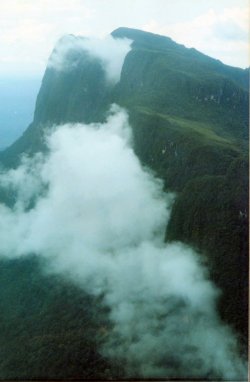 |
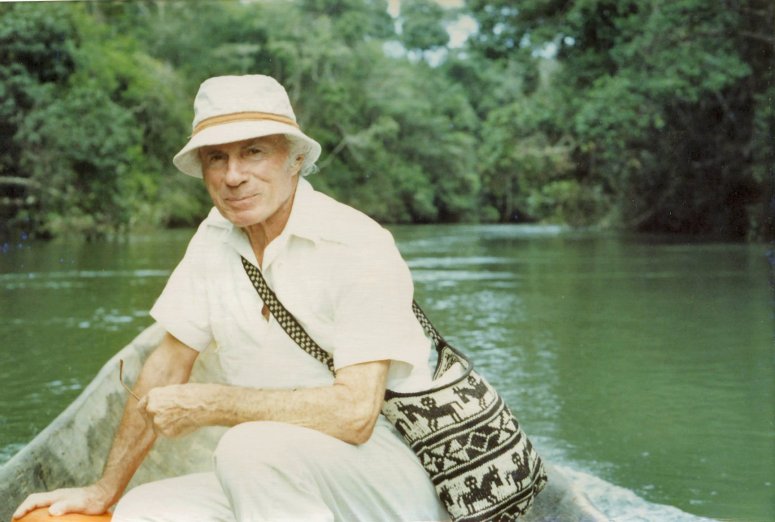
My father, Roy Pinney,
was a renowned nature writer/photographer/filmmaker with
2-dozen books, a score of television documentaries, more
than a thousand articles and countless published photographs
to his credit. President of the New York Herpetological
Society and a lifelong member of the Explorer’s Club, he had
visited and occasionally lived with some of the world’s most
primitive tribes. So this kind of mini-expedition was
nothing new to him. For me, though, it would be a first
glimpse into a world I’d only read about. Primitive
rainforest dwellers! The very words tantalized my
imagination, but nothing prepared me for the quirky,
enlightening adventure awaiting us deep in the Venezuelan
Amazon.
We got an early start,
the three off-duty guides, my father and I, piling into a
jeep and driving for nearly 2 hours on progressively rougher
forest roads. The road degraded to a track and soon ended,
abruptly, at a wall of green. We grabbed our packs and set
off on foot along a narrow trail, the guides incongruously lugging an Igloo cooler
with them.
For an hour we passed through dense, virgin rainforest, the high
canopy filtering out all direct sunlight, enveloping us in a
shadowy, tangled world of spectral views and muted sounds. As we walked I kept a
sharp lookout for wildlife, but saw very little; a few
birds, one small snake. I had expected more and commented on
this to my father. He replied simply, “There’s more than you see,
but less than you think.” Dad had a knack for saying a great
deal with a few words.
Our arrival in the Piaroa
Indio village was gradual. The rainforest thinned a bit and
we emerged onto more open ground. One small, domed thatch hut appeared
and then another; then several with a few curious Indio
women and children eyeing us warily from open doorways.
Finally we arrived at the village proper, several acres of
cleared land with more huts in closer proximity. Downtown Piaroaville.
|
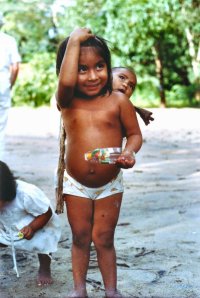 |
Here the Indios came to
us smiling, welcoming - young men, a few women and a hoard
of darting, giggling children. Most of the adults were
dressed in western-style shorts and t-shirts, light cotton
dresses for the women, a hodgepodge of faded hand-me-downs.
I had the sense they had just put them on when they heard
strangers were approaching, a notion reinforced when the
village chief appeared wearing only a white loincloth and a
necklace of small bones and animal teeth. A short, wiry man
of indeterminate age, his hair hung straight and thick and
black, parted in the middle, worn like all the men of his
tribe in a plain bowl cut.
click any
photo to... oh, hell, you know what to do




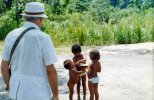 |
It was obvious these
people recognized our guides and especially the Igloo cooler, brought at such laborious
cost. When it was opened, the first ice cold Coca Cola was
presented to the chief. Then the other soft drinks
and treats were handed out to men, women and children alike,
creating a holiday-like atmosphere of smiles and banter. Unfortunately, we
couldn’t understand a word they said, nor they us. Theirs
was a soft, staccato tongue spiced with occasional nasal
sounds strange to our ears. We only had Spanish; our guides’
fluent, mine more or less conversational. My father spoke
only English (and a little Yiddish). No matter. Everyone was friendly and easygoing
and, now that the Igloo goodies were gone, most of the villagers
drifted back to whatever they had been doing before we came.
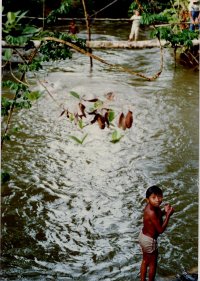 |
The chief, our guides and
a resident interpreter (more about him in a moment) began
some discussions and inspections of their respective trade
goods, practical household items from civilization in
exchange for native handicrafts from the forest. This left
my father and me free to wander about, escorted by a troupe
of happy, half naked children. They led us to the village
swimming hole, a natural pool fed by a clear stream across
which a fallen tree trunk provided a diving and
king-of-the-mountain jostling platform. I watched a while, delighted
by the kids’ antics. My father, ever the naturalist, soon
began perusing the path margins for small wildlife to study,
a troop of curious children in his wake.
|
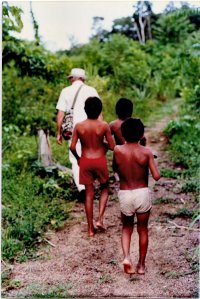 |
| |
|
|
This interpreter I
mentioned was from Caracas; quiet, long-haired, in his
early 20’s. He had been living with the tribe now
for many months, learning their language and teaching
Spanish to some of the young men so they could barter
more effectively in Venezuelan marketplaces beyond the
forest. For us he was a godsend, enabling us to
communicate with the natives, particularly the chief,
and them with us. |

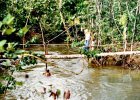
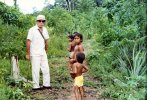 |
| |
|
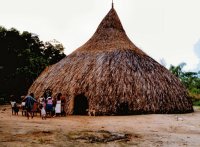 |
Dad and I returned to the
village and the chief invited us all into what was
obviously the community center, a domed thatch hut like
the others only much larger, with the tribe's signature,
gracefully curved peak at the top. The thatch came all
the way to the ground giving the appearance of a great,
shaggy, inverted bowl pierced by a single, low,
arched entranceway with a woven mat for a door and a
ventilation hole at the roof’s apex for smoke from
indoor cook fires. |
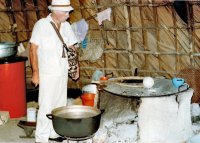 |
As my eyes adjusted to
the dim interior, I felt like I’d walked into one of those
lifelike exhibits in the Museum of Natural History, a
domestic scene 2,000 years ago. Nearly everything was
handmade from forest materials; walls, floor mats, hammocks,
baskets, a few stools, a baby’s cradle, a couple of long,
tubular blow-guns with darts for hunting monkeys and birds. Two small fires smoldered in widely-spaced fire
rings, one with a large cauldron over it. I also noted
evidence of our guides’ earlier trading expeditions; some
manufactured cooking utensils, assorted plastic bowls &
containers and a
couple of nylon mosquito nets. A few Indios were already there, including
a mother unselfconsciously breast-feeding her infant.
Several others followed us into the hut, enjoying the diversion from the ancient routine of the
village. |
At the chief’s invitation
we all sat in a circle on the floor. For a while no one
said anything, we gawking at our surroundings, the Indios
gawking at us. Then I asked the chief, through the
interpreter, what that was cooking in the cauldron, half
expecting it to be alligator meat or monkey stew. He replied
that it was beer. They were brewing beer. Now, I fancy
myself something of an aficionado where beer is concerned,
having sampled local brews all over the world. So I asked if
I could taste it. The chief said he was sorry, but it would
not be ready for a few more days, all this back and
forth through the young hippie interpreter; Spanish to
Piaroa, Piaroa to Spanish, which I translated to English for my father.
The group sat silently
again for a minute or two. Then the chief asked if I would
like to try some… he said a name I didn't know, the
interpreter simply repeating the Indio word. Well, whatever
it was I was up for it and I nodded appreciatively. What the hell, right?
An Indio brought a dish
of herb to the chief, who proceeded to roll it up in a leaf
and light it. He inhaled a large a puff and let it out
slowly. A faraway look came into his dark eyes. As soon as I
smelled the smoke I was sure it was marijuana, but the
Indios insisted it was some other herb that grows in the
forest. The “cigar” passed around the circle and we all
partook, including my then-77-year-old father who never smoked
anything and rarely drank. It sure felt like pot to me.
Later one of the guides suggested maybe the Indios were
reluctant to admit to outsiders that they smoked cannabis,
fearing problems with Venezuelan officials. Whatever, it was
one heep’m good peace pipe, kemosabe.
So now we were all mildly
high, sitting, gazing around, smiling. The chief seemed to
be studying me. After a while he asked, “Would you like to
try yopo?” Of course I had no idea what yopo might be, but true to
form I answered “sí.”
This time someone
brought a small, tightly woven, oblong
basket. As the chief opened it I asked if I could take some
photographs. Sure, he nodded, go ahead. I'm not sure
he actually knew what photographs are. Inside the
basket was an assortment of what I can only call
paraphernalia, small, specialized instruments for partaking
of a
favorite drug. Among the artifacts was a narrow Y-shaped leg bone
from some bird, the bones being hollow tubes. Small, dark
beads had been fixed to the tops of the “Y”, an addition, as
I was about to discover, both ornamental and practical. The
whole kit reminded me of what hippies back in the ‘70’s used
to call a stash basket.
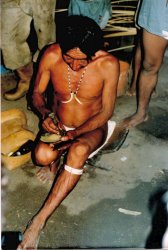
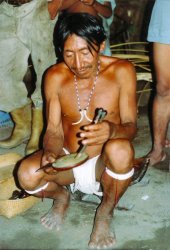
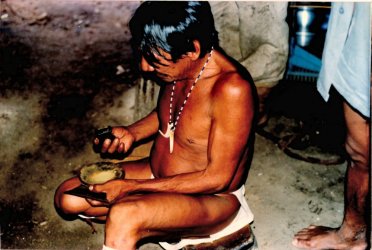
The yopo itself was
brought separately on a wood dish. It looked exactly like a
large chunk of hashish; firm, irregular, dark brown in
color. No, no, not from cannabis they insisted again. And it
wasn’t. The chief ground the chunk to a powder with a mortar
and pestle, and then laid out neat lines of it on the plate,
like cocaine. He then demonstrated, placing the beaded tops
of the leg bone “Y” into his nostrils, holding the other end
of the instrument to one of the lines of powdered yopo, and
snorting it in one swift inhale. Then he sneezed, once, and
the Indios in the group giggled a little.
The chief held up the
Y-bone and dishful of lines and asked who would like
to go next. Without any hesitation, my father – a straight,
sober man all the years I’d known him, but above all an
adventurer, anthropologist and lifelong admirer of primitive
cultures – my father knelt into the circle first and received
the offering. He tucked the Y into his nose and snorted up a
line. Then he sneezed, once, and the Indios giggled again.
Apparently there was some little joke in the tribe about the
inevitable, single sneeze that follows a snort of yopo.
The plate made the
rounds, each of us snorting and sneezing. When it got back
to the chief there was one line remaining. Who wants it, he
gestured? Well, since I had no idea what I had just inhaled,
no notion of how strong it might be, I held back. So did the
rest of the visitors. But the young interpreter from Caracas
knew exactly what yopo was and readily volunteered to finish
it. Snort, sneeze, giggle.
For a while we all sat
there, immersed in this eerie time/culture warp, sort of
waiting to see what would happen next. As the yopo took
effect I began to feel light. My perceptions gradually
became magnified and things took on more… presence, became
more real. It was as though veils were slipping away from my
eyes and I was seeing everything with a much clearer, richer perspective. For those of you readers who
have ever eaten psilocybin mushrooms, it was a lot like that but not so giddy. It felt
good. I became very absorbed in the looking and the seeing.
|
At some point we all got
up to go back outside. I pushed the mat aside and stepped
through the low doorway into brilliant, brilliant sunlight.
There, gathered around the hut’s entrance in a lose
horseshoe 2 and 3 bodies deep, stood most of the villagers,
staring at us as we emerged. Apparently the word had gotten
around that the chief had shared yopo with their guests and
everyone came to see. Their faces were deadpan,
staring fixedly. I locked eyes with one young man
and a thought occurred to me. “Oh, so this is what you
people are doing out here. You live in this tropical
paradise, eat monkeys and yucca, swim naked in the streams
and get high. Man, you’ve got it made!” As the thought
formed in my mind, I began to grin and then smile, broadly,
my eyes still locked with the Indio’s. And he seemed to
answer me telepathically, saying “Ah, now you get it,” and
he broke into a great big smile, and there we stood eye to
eye, beaming at each other across several millennia and who
knows how many cultural and cosmic dimensions. |
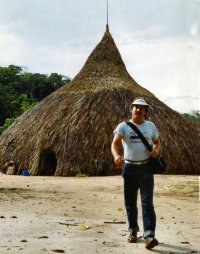 |
Then everyone dispersed.
I wandered off into the forest following a footpath, simply
enjoying the natural magic of the place. Not far along I
heard faint voices coming, it seemed, from some bushes. I
reached out and parted them to see what lay beyond. There,
standing knee-deep in a pool of clear water formed by a
forest stream, stood a young Indio couple, teenagers, facing
each other a foot apart and completely naked. They were
speaking softly and as they did they gently stroked each
other’s hair and shoulders. It was a private moment of
shared affection, unbearably tender, Adam and Eve in the
Garden of Eden.
They didn’t notice me,
but I felt guilty invading this sacred scene, albeit by
accident. Silently I eased the bushes back together and
walked on down the path, utterly enchanted by that glimpse
of earthly bliss.
When I returned to the
village my group was forming up to leave. We had a long hike
ahead of us to the jeep, and then a bumpy ride out of the
forest and back to our camp. Some of the villagers milled
around offering friendly smiles and gestures. My guides had
small bundles of artifacts for which they had traded. My
father acted as if nothing out of the ordinary had happened.
When I asked him later, he said he hadn’t felt any effects
from the herb or the yopo. Sure, Dad.
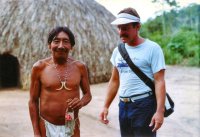 |
The chief still clung to his empty Coke bottle,
like the aborigine in the movie, "The God's Must Be Crazy."
He held my gaze
for several long moments, a penetrating, accepting look, as if
to say we weren’t so different when you see beyond the
surface. I learned later that yopo is normally reserved for
special religious ceremonies in the tribe, taken by
supplicants in doses many times larger than what we had
done, who then go into trance states, sometimes for days,
during which they visit their ancestors in the spirit world
to communicate and gain wisdom. It was rarely shared with
outsiders. |
As we walked single-file
along the path past the outskirts of the village, several
small children were playing in a tree, chattering and
laughing like so many happy monkeys. One of them held up a
hand, palm facing us, and called out, “Shao-wada-wah! Shao-wada-wah!” in
their dialect's peculiar nasal tone. One of the guides
told us, “That means ‘farewell, friend’ in Piaroa.
Thank you, good people.
Thank you
for being here. Shao-wada-wah.
~~
|
Father & Son
Roy Pinney – world-renowned herpetologist and naturalist,
award-winning photographer and
filmmaker, war correspondent, museum curator, university
professor, author and adventurer extraordinaire – died
in Manhattan in 2010, just 3 days shy of his 99th
birthday. He left behind 5 children, 5 grandchildren, 3
great grandchildren, a few good friends, many admirers
and one hell of a legacy. |
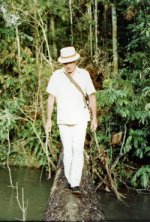 |
| |
|
|
Tor Pinney (www.tor.cc), Roy’s second son, is a
writer/photographer, marine industry consultant, sea
captain and lifelong cruising sailor with nearly 150,000
nautical miles logged under sail. His articles appear in
boating magazines worldwide and his authoritative book,
"Ready for Sea! - How to Outfit the Modern Cruising
Sailboat" (Sheridan House), is available in nautical
bookstores and online. Tor is presently revisiting the
Caribbean aboard his 42’ ketch, Silverheels.
~ End ~ |
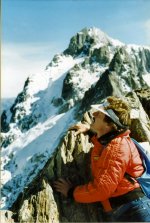 |
Back
to List of Tor's Tales